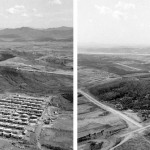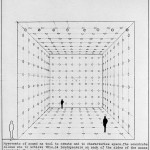Come back home right after a fast yet inspiring chat with Paris based artist Stéphane Degoutin at the 104, I and Mariabruna were curious enough to start looking at the work he did with his friend Gwenola Wagon.
In fact their sites show such an overwhelming quantity, quality and variety of production that we regret we didn’t already spend more time with him!
Ranging from media, online and installation art, theoretical texts to architectural projects, the couple’s “main research interests are mankind after man, the contemporary city after public space, architecture after pleasure.”
We can’t help featuring here two of their recent works:
The “Utopia Factory Abraxas“, a research center where different utopias can be empirically experimented by volunteers.
(This work is part of a wider research on the “Peripheral attractions by RER“. A tour by train around the outskirts of Paris is the occasion to show the projects of “Attractions périphériques” (Hypnorama, Utopia Factory Abraxas, Musée de la banlieu idéale, Wiki Forest). Nogo Voyages, a collective co-founded by Degoutin/Wagon is the organizer of such a journey, and declares itself “a projects’ laboratory whose atelier is the journey. From sightings in the suburbs of the world, the collective of artists offer movies, books, fantastic architectures.”)
(Following description texts by the authors)
UTOPIA FACTORY ABRAXAS
Stéphane Degoutin, Gwenola Wagon, 2010

Abraxas is the name of a gnostic god created by Basilides, an heretic religious teacher of the second century. The Basilidians did not believe in a magnanimous god, but rather in a demiurge, dual divinity. According to Carl Jung, Abraxas is “life and death in the same time. It engenders truth and lie, good and bad, light and darkness in the same word and in the same action”.
Thomas More first used the word Abraxas to name the island later known as “Utopia”. Presumably was he inspired by Erasmus’ Praise of Folly, in which Abraxas designates the city of the mad men. Only in the definitive version of his text did Thomas More coin the term “utopia”.
“Les Espaces d’Abraxas” is also the name of a large social housing complex buit by Ricardo Bofill at Noisy-le-Grand, a new town at the east of Paris. The building itself is undepictable: at the height of the delirious postmodern movement in architecture, made of oversized antique columns prefabricated in concrete, of dizzy perspectives and open atriums at the 17th floor, it has been used as a set for the movie Brazil.
It is rather peculiar to have chosen this name for a public housing complex. The area is often perceived negatively. Yet, it may change if one takes advantage of its oddity. Its ideal purpose was not to serve as a housing building. We propose to rehouse elsewhere the residents who wish so, let the others stay here, and t o use the vacant flats to install the offices of a Utopia Factory. The building would fit perfectly for this new use, since it already posesses the introversion appropriate for utopian places.
Utopia Factory is a research center where different utopias are experimented at full scale. Anyone can suggest a project. If it is accepted, a campaign is launched to find candidates for the experiment. The approach is empiric: the volunteers test the utopias for a period of a few months. In the event that it would not work as expected, they can experience another utopia, or come back to their previous lives.
We do not believe it is possible to build from scratch an ideal society, nor even that such a realization would bring happiness to mankind. But we do believe that the search for a better society can contribute to this goal. Therefore, Utopia Factory does not trynot to build an Eldorado, but the paths leading to it. Utopias tested here are perishable and not guaranteed. They do not aim for perfection, but rather to put the society into movement.
Utopia Factory Abraxas functions in a network of other Utopia Factories around the globe: Shanghai, Cape Town, Bronx, Tromso…
The second work here is the “Terrorism Museum“, an airport-shaped project which offers an ‘immersion in the imaginary of the terror’.
TERRORISM MUSEUM
Eléments pour un musée de l’imaginaire terroriste
Stéphane Degoutin, Gwenola Wagon, 2009-2011.
>> INFILTRATION TECHNOLOGIQUE DANS L’ESPACE AEROPORTUAIRE

Terrorism museum is a project for an international airport. Localized in the transit areas of the the world largest hubs, open day and night, it offers an immersion in the imaginary of the terror.
Because of its ubiquitous safety procedures, the airport already is a terrorism museum. It places the traveler in a maximal state of alert. One roams inside visible and invisible security devices, which tend to cancel the slightest probablility of a threat. Yet, in a vicious circle, the more present is the surveillance, the more real the threat seems.
In the airport, several fantasies find themselves merged, under their most concentrated and hysterical form: the fantasy of the disaster, of the absolute surveillance, of the omnipresence, of unlimited shopping.
These smooth and hygienic spaces look as if they were designed to be the target of an attack. The place which used to be a symbol of speed, progress, and unlimited acces to the human difference, has become a place of stagnation, anxiety, air conditioned custody, as if one found himself the prisoner of a shopping center extended to the whole planet, indefinitely waiting for a plane crash or a hijacking that will never come. Desperately virtual, the threat becomes the object of a tension that proves impossible to unravel between the reality and fantasy, itself representative of the mechanism by which the terror spreads.
It is on this very point of tension, where it becomes possible to understand the mechanism of terror, that we implement the Terrorism museum.

Terrorism Museum is an application for smartphones. Sounds and videos are launched depending on the visitor’s position in space. Virtual reality glasses are provided, while he swallows a capsule which alters his mental state. Thus equipped, he wanders around the different zones of the airport, which appear transformed*.
The museum is not separated from the reality: it is an additional layer superimposed on the actual place. The public visits the museum while checking in his luggage, passing through the metal detectors, waiting for his plane, wandering in the duty free shops…
The furtive museum infiltrates the spaces devoted to security and the potential targets they constitute. It insinuates through he available networks (Gsm, Wifi, Gps…), everywhere in the airport, including in the surveillance areas and the forbidden rooms. No authorisation is necessary for its installation. Nothing indicates its existence. No one is aware that you are visiting the terrorism museum.
The museum takes the form of a series of geolocalized essays. Each zone of the airport is augmented with a layer of questions. Is the Occidetal world under the threat of a destruction it has himself dreamt? (Departures board) What will be the means to spread the terror tomorrow? — Future threats: a trend book. (Cafeteria) The toilets are filled with the voices of conspiracy theory adepts. Habermas, Sloterdijk and Virilio chat in the duty free shop. Escerpts of the Ballard novel Millenium People are staged in the parking lots. The viitor moves around the labyrinthic spaces of the museum, between the voices of philosophers, writers, directors, artists. True ghosts, as George Orwell, walk alongside with Don De Lillo, artists as Alain Declerc, Johan Grimonprez, surveillance specialists, secretaries, secret agents…

Why a museum of terrorism ?(Entry / Exit) Is the word “terrorism” valid ? Why is it used so frequently in contexts so different (organized terror by the state, violence by the oppressed…) ? Where do we locate its limits ? (Lost and Found) Why devote a museum to the imagination of terror ? Who uses terror, when, and to what end ? What does collective terror feel like ? How does it distinguish itself from individual terror ? (Deep Tunnel Kafka) Does an attack on public transport boil down to a fight against human movement ? Is its aim the heart of the modern world ? Is an airport the collective imagination’s most sensitive target ? Does it threaten civilisation even in the place where civilization directly connects itself ? Is it an attempt to curb the universalist dream of the unity of mankind ?(Habermas Elevator) Or, on the failure of universalism ? Do activists really threaten the network of data transmission, those cables that stretch thousands of kilometers under the ocean and allow globalization to
proliferate ? (Speculative Bubble) Will a viral system replace the threat of organized networks ? Is it possible to spread terror through the flu, the plague, or a virus that would contaminate people without discrimation (ideological, religious, ethnic, sexual, societal) ?(Derrida Corner) At what point ca we talk about total security ? Does the spread of security systems bring about a weakening and permanence of collective fear ? (Escape Chute) In a climate of extreme vigilance, how can we not be suspicious of everyone ? Does not the fear of danger risk being more noxious than danger itself ? Does a system based on prevention and simulation not engender a risk of widespread fellow suspicion ? Is surveillance as frightening as it is desirable ? How do we transform public places into something other spaces of suspicion ? At what point is a surveillance system a threat to democratic society ? Can the spread of surveillance minimize the fear of others – of all others- like television was able to minimize boredom ? (Red Scan Box) Do we live in a society of inspection ? (Deleuze Post-Scriptum) Is the ennemy inside or out ? Can we really keep a population in a state of alert while extrapolating terror, whire rendering it as probable as our next breath ? Is the invisible threat being used to reinforce the cohesion of a heterogeneous group, of disparate individuals, of a nation, of a state ? (Orwell Paradise Island) Does the West convey the idea of an omnipresent threat by mixing real danger with fantasy ? Does Hollywood mythology contribute to the fascination with destroying the West, particulary the United States, with recurring scenes ? (Baudrillard Vortex) Is September 11th the materialization of a dystopian Western fantasy ? (9/11 Hotel) Is the real subject of the museum the dystopian imagination of global cities ?

Museums of terrorism already exist. We can cite the Center for Empowered Living and Learning (CELL) of Denver (USA) and the International Center for Counter Terrorism in Herzliya (Israel) or the hall devoted to the “Kurd question” at hte war museum in Istanbul.
The aim of each is to denounce the political use of violence. We look to penetrate the interior of their logic, to make the connection between complex realities and the questions they raise, to bridge different points of view.

Would it be easier, as Elias Canetti argues, to declare a global war than to burn a single individual in a public place ?Is it because all attacks on the individual have become inconceivable in modern societies or because the states find themselves forced to fill all of the cracks in security ? (Don De Lillo Reverse Stairs) Does terror make good use of the characteristics of our civilisation (fear of death, for example, the exaltation of the individual), to insinuate itself like a parasite ? (Grimonprez Lounge) Does the city that refuses terror create the conditions for terror ? In what ways – anti-liquidity, accident, chaos, and all gives rise to a radical rupture within that system- are they manifestations of the utopia of control, of absolute security, in the height of the disappearance of the violence of eveyday life ? (Millenium People Baggage Claim) If the possibility of proliferating terror stems from our vulnerability, are the conspiracy theories that suspect an inside enemy redundant ? (Conspiracy Massages) Are we surethat the gap between an absence of lived experence of violence and its sudden, hyper-speculative eruptions in the media give terror its symbolic power ? Does not the discussion of terror rest solely on the fascination that it exercises over us ? Does it impose itself upon the imagination acording to a principle similar to the sacred with the same irresistible power that the divine imposed upon traditional societies ? Will its ghost continue to haunt us long after we have “explained” or deconstructed it, just like the shadow of God, according to Nietzsche ? (Nogoland Bits) If we manipulate it, if we divert this fascination, do we escape its grasp ? Is it futile, then, to evade it without asking the question of belief ?

Exploring the application “Elements for a museum of terrorism imaginary” (Beta) at Charles de Gaulle.

Exploring the application “Elements for a museum of terrorism imaginary” (Beta) at Charles de Gaulle.

Aerial view of Charles de Gaulle airport’s Terminal 1, where the museum will take place’.

View of the Ipad application “Elements for a museum of terrorism imaginary”.

View of the Ipad application “Elements for a museum of terrorism imaginary”.






[…] the collective of artists offer movies, books, fantastic architectures.”). [via @____thenomad]Via socks-studio.com Évaluez ceci : Share […]